|
Research Interests:
I have a broad research interest in the neuroendocrine regulation of animal development, reproduction, metabolism and aging. This broad interest came from my diverse scientific training. I was trained in developmental biology and insect physiology during my Ph.D. study, and currently I work as a postdoctoral research associate at Brown University focusing on biology of aging. Aging (or senescence) remains one of the most fascinating, yet poorly understood phenomena in biology. Age has been recognized as a major risk factor for a range of human diseases, such as neurodegeneration, sarcopenia and heart disease.The treatment and costs associated with aging-related diseases contribute to substantial personal, societal and economic burdens. Resolving the contributing mechanisms of aging-related disease is a pressing goal of basic and translational aging research..
Over the past few years, my research interests have focused on autophagy/lysosome, protein homeostasis and their roles in muscle aging. Autophagy/lysosome system provides proteolytic mechanisms to regulate protein turnover and degradation. Accumulated evidence suggests that the effective removal of protein aggregates and damaged mitochondria via autophagy contributes to the crucial mechanism for the maintenance of tissue homeostasis and tissue functions. I have recently identified the role of TGF-beta signaling and autophagy in muscle homeostasis and longevity in Drosophila, the fruit flies. My future research goals aim to elucidate the genetic and molecular pathways that modulate autophagy/lysosome system and age-related pathologies during muscle aging (including aging of heart muscle).
Postdoctoral Research Projects
|
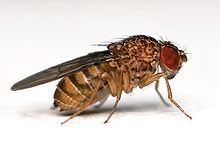
The fruit flie, Drosophila melanogaster
(Courtesy of Bbski on Wikipedia)
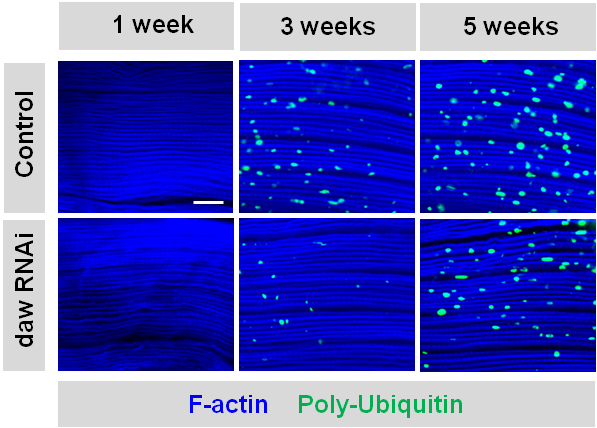
Poly-Ubiquitin-positive protein aggregates (green) accumulated in aging flight muscle
|
Project 1. The role of TGF-beta/Activin in the regulation of autophagy and protein homeostasis during muscle aging
In all cells, including those of skeletal and heart muscle, the ubiquitin-proteasome system (UPS) and autophagy/lysosome system provide proteolytic mechanisms to regulate protein turnover and degradation. Autophagy is an evolutionarily conserved process for the removal of damaged cytoplasm components and organelles. It is cytoprotective and exhibits potent anti-aging effects.
I have recently identified TGF-beta/Activin signaling, as a negative regulator for longevity and autophagy of skeletal muscle in Drosophila. However, the detailed mechanisms of this regulation are not fully understood. In this projects, I aim to decipher the molecular basis of TGF-beta/Activin-mediated autophagy function and protein homeostasis in aging muscle and the muscle-derive hormonal facotors that contribute to systemic aging control. This work has the potential to delineate novel hormonal pathways that regulate tissue homeostasis during aging.
Research
Goals:
1. To decipher the mechanisms through which Activin signaling controls autophagy and muscle functions during aging
2.
To identify the muscle-derived hormonal factors that mediate systemic aging control.
Approaches:
1.
Cellular autophagy assays, muscle funtional analysis (climbing and flying)
2. Muscle secretome analysis, lifespan analysis
|
|

A snapshot of dFOXO ChIP-Seq in Genome Browser
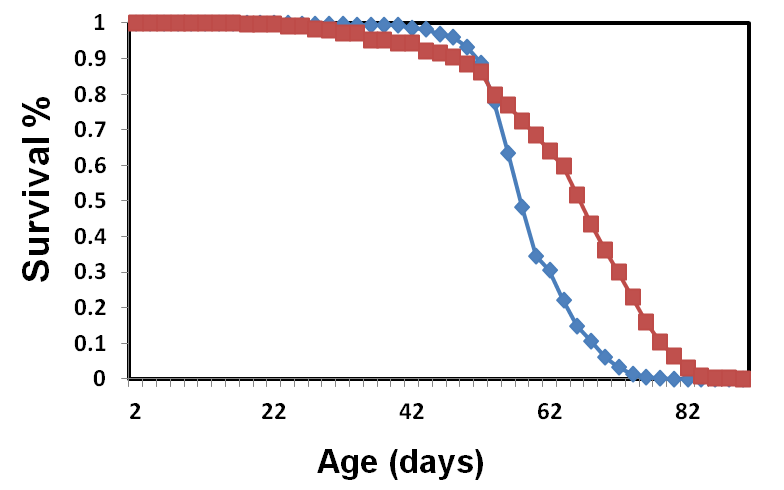
A typical survival curve
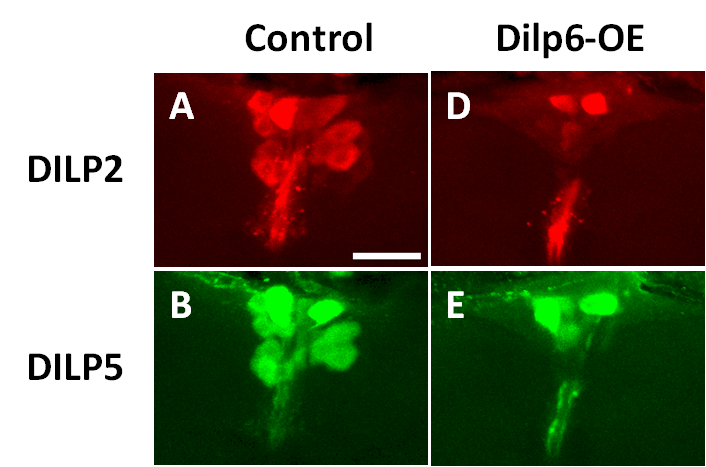
Immunostaining of insulin-like peptides (DILPs)
|
Project 2. How insulin/IGF-1 signaling regulates longevity in Drosophila?
Reduced insulin/IGF-1 signaling increases the lifespan of
nematodes, flies and rodents. However the underlying molecular mechanisms of
this robust effect remain unclear. Genetic evidence places forkhead transcription factor FOXO as the downstream effector of insulin/IGF-1
signaling. Thus, insulin signaling through its control of FOXO is a potentially universal system to regulate aging.
The goal of this project is to identify the proximal targets of insulin/FOXO signaling that orchestrate these mechanisms of
longevity assurance.
Research
Goal:
To identify downstream effectors involved in insulin-mediated
lifespan in Drosophila
Approaches:
1.
dFOXO Chromatin-immunoprecipitation-sequencing (ChIP-Seq)
2. Lifespan analysis (demography)
|
Graduate Research Projects
|
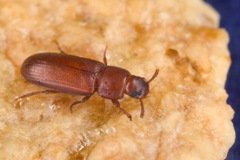
The red flour beetle, Tribolium castaneum
(Courtesy of Peggy Greb, USDA-ARS)
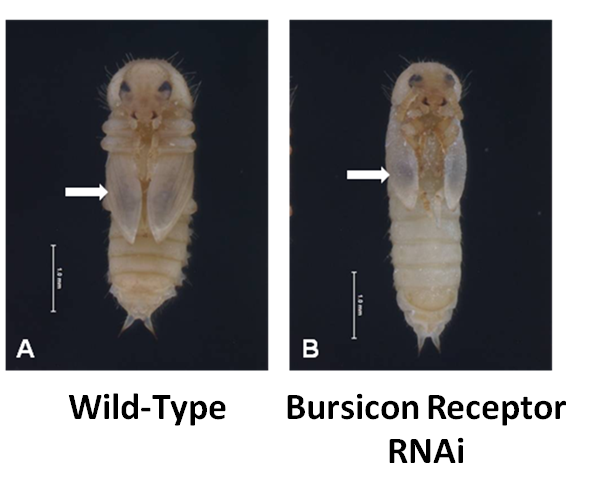
Effects on insect development by RNAi targeting bursicon receptor
|
Project 1. Large-scale RNAi screen of G protein-coupled receptors (GPCRs) in the red flour beetle, Tribolium castaneum
G protein-coupled receptors (GPCRs) belong to the largest superfamily of integral cell membrane proteins and play crucial roles in physiological processes including behavior, development and reproduction. Because of their broad and diverse roles in cellular signaling, GPCRs are the therapeutic targets for many prescription drugs. However, there is no commercial pesticide targeting insect GPCRs.
In this study, I employed functional genomics methods and used the red flour beetle, Tribolium castaneum, as a model system to study the physiological roles of GPCRs during the larval growth, molting and metamorphosis.
Research
Goals:
1. To identify all non-sensory GPCRs inTribolium genome
2. Apply RNAi screen to study the physiological roles of identified GPCRs
|
|
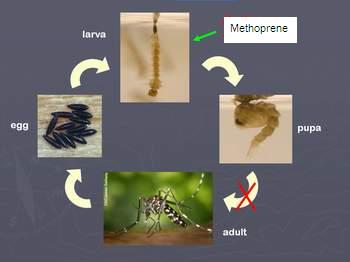
Life cycle the yellow fever mosquito, Aedes aegypti. Methoprene blocks the transition from pupae to adults (Courtesy of Yu Wu)
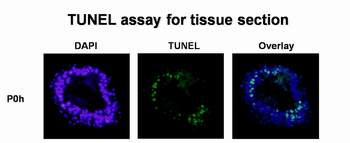
TUNEL assay was used to monitor cell death occuring at the midgut remodeling
|
Project 2. Hormonal
regulation of midgut remodeling during metamorphsis of the yellow fever mosquito, Aedes aegypti
The Yellow Fever Mosquito, Aedes aegypti, is a historically primary vector for the
viruses that cause human dengue and yellow fever. Methoprene, as a juvenile
hormone (JH) analogue, has been used for decades as a major larvicide to control mosquitoes. However the mode of action of methoprene
is poorly characterized.
This project is focused on the role of methoprene in modulating midgut remodeling of A. aegypti. Knowledge gained from this study will be useful for development of novel strategy for mosquito control and slowing down the
development of methoprene-resistance in mosquito populations.
Research
Goals:
1. To uncover the underlying mechanisms through which methoprene blocks the transition from pupae to mosquito adults
2. To study the role of methoprene in ecdysone-mediated metamorphosis in mosquitoes |







